star-power, fetishism and sexism in Alfred Hitchcock's Vertigo
Submitted by admin on Mon, 06/10/2024 - 14:45Sight and Sound's 2022 Top 100 Greatest Films List places Vertigo at number two. Wherever it may score on a best list, the film endures as an ambitious heterosexual fantasy, with unique cinema story strands and scenes. Is there another film that shows a girlfriend modeling black pumps and full-fashioned hosiery in the shoe department of a fancy department store while her boyfriend asks the salesman, "Do you have those in brown"?
A conscientious restoration of the film now streams on Amazon Prime for a fee. The same version is available at the Internet Archive without fees. Its intimacy, deft direction and smooth graphics render it worthy of another watch.
Mr. Sinerker has been writing about fetishists, fetishism and fetishes for many years. He wrote a prose piece about Vertigo and offers it to us for publication on the Fetish Nostalgia website. It's not a movie review.
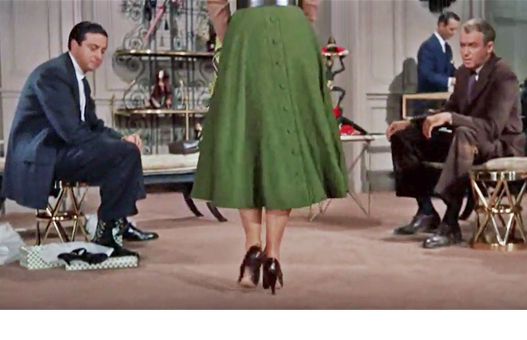
The Other Side of Vertigo by Rolf Sinerker
We've seen Jimmy Stewart play roles of sweet and extraordinary men for about 20 years by the time Vertigo premieres in 1958. Because of his filmography, we expect John Ferguson, the Vertigo protagonist, to have exceptional talent or virtue.
In Vertigo, Mr. Hitchcock sculpted a truncated adult without admirable features. It's almost impossible for us to know this when we meet him, chatting about his interest in nothing in his friend's apartment. Our movie-going experience taught us that Jimmy Stewart expresses an emblem of decency, maturity and even heroism. Although John Ferguson does nothing to show what's worthwhile about himself, we still think he must be a great guy because he looks just like Jimmy Stewart.
Our affection and respect for Stewart characters in feature films we've seen before Vertigo leads us to misapprehend John Ferguson. Had he been played by Dick Powell, Fred MacMurray, or Kirk Douglas, we might have been a bit more suspicious when he kisses the married lady.
In casting Mr. Stewart in this role, Mr. Hitchcock may be misdirecting our expectations. Instead of an exemplary Jimmy-Stewart-type character, the author presents a mediocre male who embodies many objectionable qualities. John does jump into San Francisco Bay to rescue a woman, but later, we watch him lie to her about his reason for being there. Watching the protagonist lie should be incongruous for us, but we accept his protector role as justification.
In other mid-century films, Jimmy Stewart toils to find the truth, save lives, or protect his country. Here, he's dishonest with his only friend, initiates liaison with another man's wife and convinces a working girl 20 years his junior to dress like a woman who died. While he may have reputation for rationality, we watch the John Ferguson character lose his bearings over a woman in a vertigo-like turmoil that spins him out of his mind.
• • • • •
Gesture, artifact, dialog, and the protagonist's connections to people reflect cultural context. Reacting to events in his life, the Ferguson character transitions through a series of phases.
POLICEMAN
The first time we see John Ferguson, he's chasing a suspect across apartment building rooftops with a uniformed officer. On his last jump between buildings, he slips and hangs from a sagging rain gutter by his fingertips. While trying to rescue Ferguson, the officer slips and falls to his death.
For the first time in his life, he's afflicted by sensations of vertigo, suspended seven stories above the alley. It's fair to say that if you're hanging by your fingertips seven stories up, vertigo isn't your biggest problem.
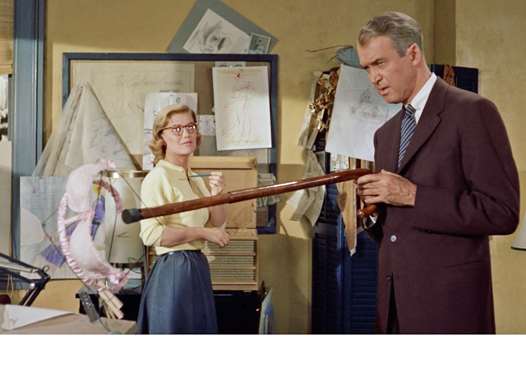
RETIREE
The first scene in Midge's apartment tells us who's who and what's what. Scottie — Midge calls her college chum Scottie and Johnny-O — explains that he is about recovered from the back injury that troubles him since the hanging incident. Health conditions justify early retirement, and he plans to do nothing with all the free time he now has as a man of “fairly independent means”.
They were engaged for three weeks during their college days, and she allows him to say the story ends with Midge calling it off. He tells her that he's still available, that is, if she wants to propose to him. He likes to take Midge out to a bar, to dinner or the movies. But there's no kissing. Still, she believes that Scottie is her personal property, and wouldn't like some rich guy's wife trespassing on her territory.
A commercial artist whose biggest client is a department store, Midge has a brassiere posed on the corner of her drawing table and Scottie asks, "What's this doohickey?" Here, Mr. Hitchcock wants us to know that Johnny-O knows little about women, has little fluency with women's things.
When we meet Scottie, we find a guarded man with average gifts and conventional beliefs. He's not curious about much, which includes his future as retiree. As we see him engage with others, we learn that he's a polite person who reads newspapers and Swank magazine, and thinks of liquor as medicine.
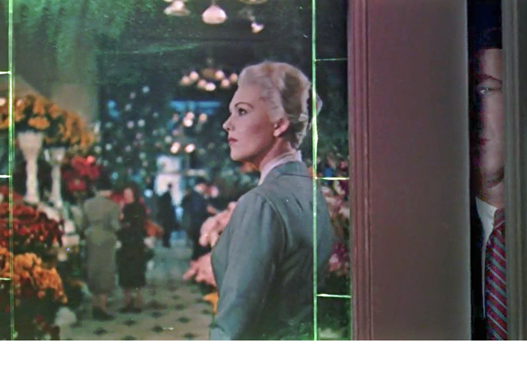
GUMSHOE
At Gavin Elster's office, Scottie doesn't want to get involved in the “darn thing” of Madeleine's wacky construct about being inhabited by a dead woman's spirit. To persuade Scottie, Gavin says, “You can see her at Ernie's . . .”, believing that once that happens, he will be intrigued.
With few exceptions, private detectives in movies get lied to the first time they meet a client. As this is Scottie's first day as a gumshoe, he doesn't know enough about the job to expect his client to lie (or that Gavin's entreaty is the first stage of an ornate set-up).
Missing from this first meeting of client and PI is the price, something like $100 a day plus expenses. The absence of remuneration supports Scottie's integrity as non-mercenary friend who only wants to serve and protect.
As tenacious tracker, he follows Madeleine's green Jaguar sedan in his DeSoto coupe. She turns into a downtown alley and walks through the rear entrance of the Podesta Baldocchi flower shop and Scottie follows.
His left eye peers between the edge of the open door and the jamb, a classic voyeur tableau. A shadow bisects his eye as he examines his charge, up close for the first time, dressed in her monochrome urban uniform — gray suit, white scarf, white blouse, black pumps. The mirror embedded in the door shows us both observer and observed. Madeleine turns and inspects flowers — assuring us that she doesn't know anyone's watching her — and leaves with a nosegay bouquet.
In his sporty hardtop, Scottie follows Madeleine to Mission Dolores, through the church to the cemetery, where they separately inspect the headstone of Carlotta Valdez. In the museum, she sits and ponders Carlotta's portrait, and he ponders the similarity between Carlotta's bouquet and Madeleine's flowers, Carlotta's coiffure and Madeleine's.
Then, the old hotel, where he loses her.
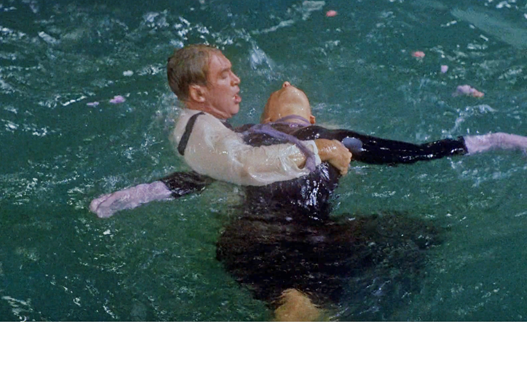
RESCUER
On a subsequent excursion, Scottie tracks her to the Palace of the Legion of Honor museum and then to Fort Point, the south end of the Golden Gate Bridge. There, she pulls flowers from the bunch she had with her at the museum, lets the petals fall into the water, and jumps into the bay. He rescues her and brings her to his home.
After he removes all of her clothes and hangs them to dry, Madeleine sleeps and mumbles in his bed. A ringing landline awakens her.
Disoriented in unfamiliar surroundings, she asks for an account of events, none of which she remembers. As observed by Parker Tyler about 1930s American talkies, wealthy characters speak with British accents as aural insignia of aristocracy. Madeleine's speech has a faintly British quality during conversations with Scottie. And while we're on the subject of speech, the Ferguson character's dialog in Vertigo is devoid of Jimmy Stewart's familiar modesty stutter.
The following day, they become fellow wanderers, visiting ancient redwoods and rugged coastline. Scottie peppers his anguished companion with questions, searching for “the key” that will return her to reality. They embrace and enjoy their first kiss beside bursting ocean surges.
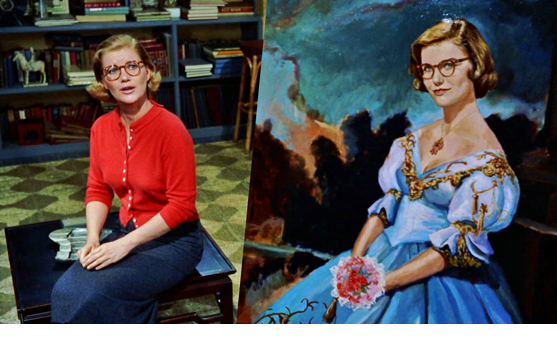
DEFENDER OF THE FAITH
In the third Midge apartment scene, when she asks, “What have you been doing?” it's with a tone that betrays a sense of ownership of her onetime fiancée. He lies.
In the Midged-up Carlotta portrait, the artist ridicules both Madeleine and Scottie. Midge's satiric parody picks at his wandering squeeze, her occult delirium and says, in effect, “If you're looking for a woman who wears a certain dress or is possessed by spectral delusion, Midge can be your girl.”
In consideration of their friendship, Scottie expects Midge to show respect or empathy for a woman who's confused by sensations of reincarnation. Making a joke defiles the perfection he attributes to the Madeleine he's met and fallen for. As a person without wit, Scottie feels hurt and dismayed by Midge's painting and departs. In frustration and self-loathing, Midge grabs a brush and defaces her own creation.
FIXER
When Madeleine appears at Scottie's front door at sunrise, she's panicked. He conducts a quick interrogation, in which she recounts the details of her recent dream about a place he has visited. (For this to work as part of Gavin's murder camouflage, he must be aware that Scottie knows this place and will offer it as explanation to the woman impersonating Madeleine.) In pursuit of a remedy for her debilitating beliefs, Scottie suggests that she return later in the day, when they will drive down to Mission San Juan Bautista. There, she can see the historical artifacts that ornament her dream.
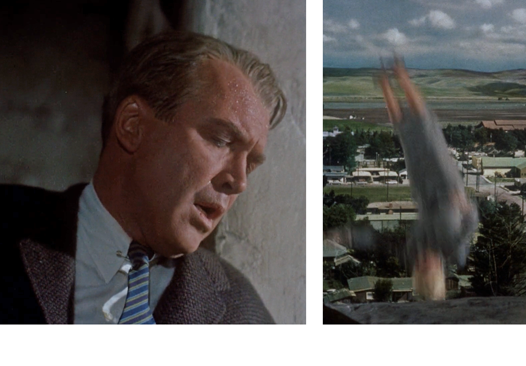
FAILURE
He shows her the carriage and gray horse in the mission stable to convince her that her dream was influenced by her visit(s) there. She runs away, toward the bell tower. His acrophobia prevents him from getting to the top of the staircase and protecting his precious object from harming herself.
INVALID
After the unpleasant inquest and “rough” summary, Scottie sweats through a dream animated by swirling flower petals, flashing colors, Carlotta, Elster, and a man in a suit falling. Next thing we know, he's a patient in a San Francisco nursing home, hugged and petted by Midge. “Mother's here,” she says. His diagnosis: “. . . acute melancholia together with a guilt complex.”

SEARCHER
Scottie strolls San Francisco sidewalks, Ernie's, the Palace of the Legion of Honor, and Elster's apartment building parking lot looking for the woman he lost or someone who looks like her. In front of Podesta Baldocchi, Scottie sees four women chatting and walking. After goodbyes, three cross the street, leaving Judy Barton by herself. While we recognize Kim Novak (even as a brassy redhead), Scottie believes he's looking at a person he's never seen before. His good news: her profile matches Madeleine's.
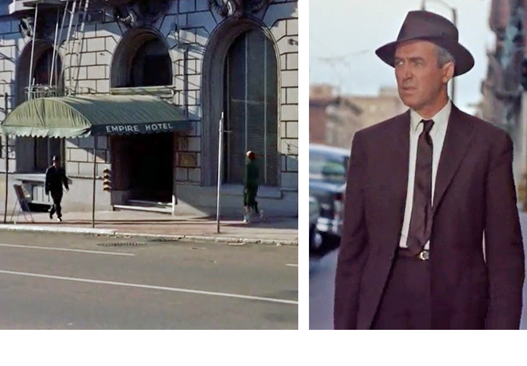
STALKER
As a distanced pedestrian, Scottie follows Judy to her hotel room, knocks on her door, and asks her to dinner. The woman from Salina, Kansas admits, “I've been picked up before,” and documents her pretense that she was never the deceased blond for whom he yearns.
FETISHIST, part one
Some practitioners believe that fetish ideation develops after trauma. If that's true, the violent death of Madeleine — and his role in it — could have provoked Scottie's fixation. As the story shows late-in-life onset and absence of connection to any single object, process or substance, Scottie's mania is distinguishable from that of an archetypal fetishist, but his obsession drives him to behave like one.
After a few dates — dinner at Ernie's, Golden Gate Park, dancing at a supper club — Scottie feels he has enough mileage in their friendship to justify popping the crucial question: will you dress up for me? After he countermands her choice of flowers at a pushcart, they jaywalk over to Ransohoff''s department store, where Scottie can start assembling what he really wants — a Madeleine facsimile.
He asks the department manager to show them gray suits. Judy likes two of them, but neither matches Madeleine's.
When Scottie says, “ . . . . please. It can't matter to you,” he disparages Judy and her preferences, which distresses her. If he knew anything about being a fetishist boyfriend, he would have bought her one suit that she likes and one like Madeleine's. As a man of little experience with women (doesn't recognize a bra when he sees one), he's unaware that diplomacy can facilitate attainment of selfish objectives in girlfriend/boyfriend relationships.
MANIPULATOR
When he says, “I just want you to look nice,” he lies, trying to conceal the goal Judy has identified as, “You want me to be dressed like her.” He lies again to obscure his intent with a phony credential, “I know the kind of a suit that would look good on you.”
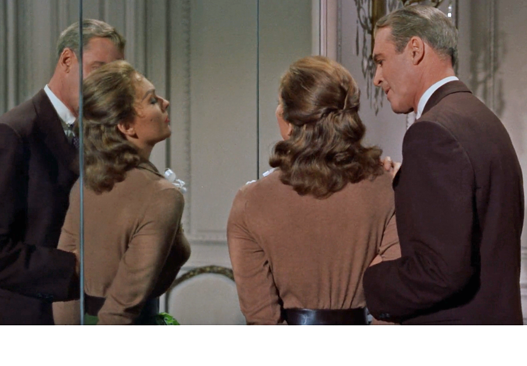
MISOGYNIST
When Scottie says, “Judy, Judy, it can't make that much difference to you,” he attempts to draw her attention to their hierarchy — a discerning San Francisco gentleman has higher status than a country girl who's moved to the city. His arrogance resonates when he insists, “Judy, do it for me,” with a fistful of gravel underscoring “me.”
It's a hierarchy based on the alleged superiority of men. And on class: a college graduate of “fairly independent means” outranks a Kansas transplant who lives in a dingy hotel. Her reluctance to be submissive to the person in the room who's wearing the wingtips provides him with license for wardrobe tyranny.
FETISHIST, part two
The second episode in their painful discussion of his apparel business occurs later that day, at his apartment. She objects to being recast in another woman's image. Scottie replies, “No, Judy. Judy, it's you, too. There's something in you that — ” his attempt at sweet talk. “Couldn't you like me, just me, the way I am?” she asks with tears in her eyes. How many fetishists' girlfriends have grumbled, as Judy does, “When we first started out, it was so good, we had fun. . . . And then, you started in on the clothes”?
A whisper about changing her hair color subverts his credibility. But she capitulates to his wishes.
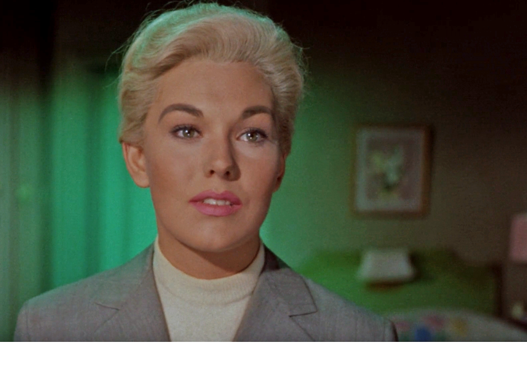
[THE MOVED CHARACTER]
In Vertigo, an average individual wants nothing when we meet him. Then, a deluded but serene silhouette of cool feminine poise enchants him, and he's seized by sudden desire for her — like “the thunderbolt” that assails Michael Corleone when he meets Apollonia in Sicily. After the death of Madeleine, Scottie pursues a desperate plan to synthesize a duplicate using a vulnerable woman, lies and merchandise.
The first Scottie and the moved Scottie have this in common: they have no interest in developing a relationship with a woman — a person with a personality, ambitions, stories to tell. He's not interested in getting to know anyone, share his life, disclose his fears and aspirations, but is hopeful that someone dressed as Madeleine will be all the woman he needs. He's looking for a companion, not companionship — someone (please don't call her a mannequin) to look at across a table. Even a girl as attractive as Judy Barton, someone as lovely as movie star Kim Novak, isn't good enough for Scottie since he became enthralled by who he thought was Gavin's wife.
In a breeze of gauzy light, Judy exits the hotel bathroom — in the correct gray suit, white blouse, hair pinned up — and steps into focus. Her facial expression morphs from miffed (are you happy now?) to confident (finally, he wants me) to adoring swoon. Scottie kisses his blond, grateful for her compliance. Images of the mission, where he last saw Madeleine in the gray suit, move behind rotating smoochers.
OUTRAGED VICTIM
As part of her getting-ready-for-a-date protocol, Judy stands in front of the hotel room mirror and asks Scottie to fasten Carlotta's necklace at the back of her neck. This shoves his attention to desolate awareness that Judy has betrayed him twice, and Gavin has orchestrated diabolical deceit, casting Scottie as exonerating witness.
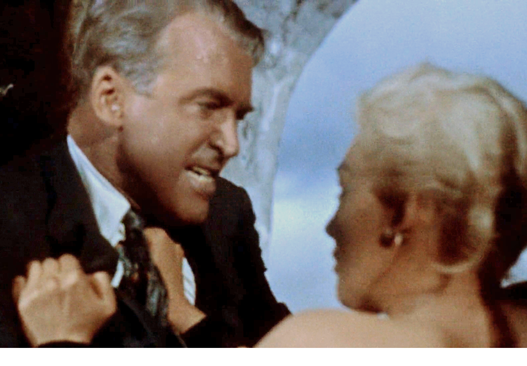
PUNISHER
Aware of his victimhood, he feels righteous anger, wants to hurt the conspirator who's nearby, and takes her to the mission, the site of his fabricated failure. While forcing her up the twisted staircase of the bell tower, he indicts her for cruel exploitation of his innocent trust and cagey manipulation of his feelings. By accident, Judy falls to her death.
• • • • •
There's sleazy tackiness to Scottie's quest in his skewed universe. Judy's aware that his insistence on replicating what he believes to be Madeleine's style was what Elster paid her to do. Scottie's obsession returns Judy to Elster's regime and betrays Scottie's infatuation with another man's female idiom.
Vertigo incidentally exposes simple, 20th century sexism as a covert construct that underlies male identity. It's not so much a motif as it is reflection of invisible attitude, deeper than faith or ideology. We can't say it's the theme of the film about a man who plots to kill his wife, but we hear manifestations of it when male characters speak.
Three characters utter the word “power” during the course of the film. While Scottie admires a painting of 1849 San Francisco, Elster waxes nostalgic about an era he never lived in, lamenting how the city has changed. “Color, excitement, power, freedom,” he says, longing for yesteryear. An hour later, in a flashback that shows him throwing his wife off a building, we see how Elster defines power and freedom.
In the Argosy Book Shop, Pop Liebel tells what he remembers of the Carlotta legend. “A rich man, a powerful man,” discovered “the beautiful Carlotta” dancing in a cabaret. “And he took her and built the great house [for Carlotta]. . . . But then, he threw [Carlotta] away. You know, a man could do that in those days. They had the power and the freedom.”
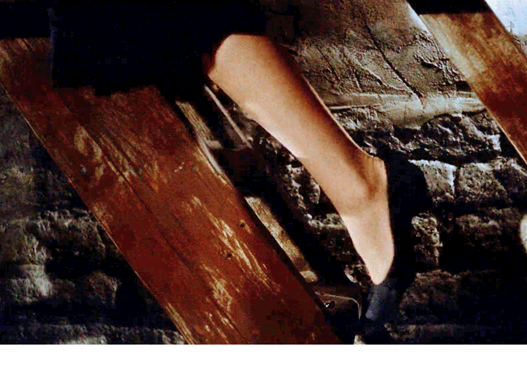
In the last sequence of the film, at the top of the bell tower, Scottie taunts, “Oh, Judy, with all of [Elster's] wife's money and all that freedom, and that power and he ditched you. . . .” Not the ability to build a railroad or blockade a seaport, when uttered in Vertigo, power means the ability of a man to discard a woman by murder or more casual means. Carlotta's onetime benefactor was able to accomplish this without consequences. Elster winds up disposing of two women. His criminal devices provoke labyrinthine narrative, and our protagonist gets lost in it.
• • • • •
As a symptom, spinning sensations characterize vertigo, causing dizziness, which can lead to a fall. Scottie's sudden desire for his friend's wife disorients him, and he transforms into a man who wants something he can't have and shouldn't want. His lust displaces whatever pattern of ethics he might have followed when he's recruited as body guard, and he doesn't notice his own adulterous urgency. (And we don't notice it either, because James Stewart plays Scottie.)
Believing Madeleine to be dead, he embarks on an expedition to contrive a replica. Only the most naive man would believe it possible to find satisfaction by reconstructing a lost sweetheart. “What good will it do?” Judy asks, skeptical that this bizarre venture will succeed. Nevertheless, she negotiates for what she wants: “If I do what you tell me, will you love me?”
The title of the movie functions as metaphor for the frantic passion Scottie feels for the woman he watches. We like to generalize that Mr. Hitchcock's stories show ordinary people in difficult circumstances. In Vertigo, a middle-aged man falls in love with a shadow.
